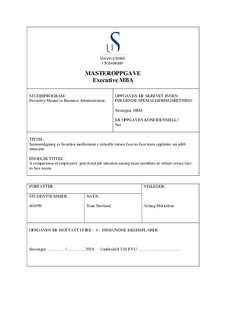| dc.description.abstract | The globalization and increased competition, in combination with pressure to quickly adapt and find good solutions in complex situations, has forced companies to change organizational structures. To organize in team, is seen as an instrument to get a more flat and flexible organization. Team is recommended as best practice HRM, and seen as a tool to create high performance organizations. Over the years, computer based technologies for communication has developed and the usage has increased, and as a consequence virtual teams have been widely used already for several years within a lot of companies. There might be several reasons to organize using virtual teams, compared to co-located or face-to-face teams. Reasons like utilizing team members sitting closer to customers or important markets, and finding people with the correct skills and competence despite geographical location more easily can be mentioned. The purpose of this study is to see if different team organizing, virtual and face-to-face, has an impact on the employees’ perceived job situation. This is seen in the light of the company’s selections of practices within best practice HRM, to create a high performance organization to operate in a global and complex market situation. Can the same HRM practices be applied to people working in these different type of team’s, without significant change in the employees perceived job situation? Theoretical background is collected from strategic HRM and theory concerning employee motivation, and in addition theory around teams in general and virtual teams in particular. The research in this study is done within Wärtsilä, and seen in the light of the context in the company. Virtual and face-to-face teams are selected within two different business lines in the organization. Data is collected from all selected teams, and all team members’ answers in the employee satisfaction survey MyVoice conducted in 2015. The data show that there are no significant differences between team members who are part of a virtual team or a face-to-face team for any of the variables or categories in this study. It can be concluded that implementation of HRM practices can be applied to people working in these different types of teams, without significant change in the employee’s perceived job situation. | nb_NO |

